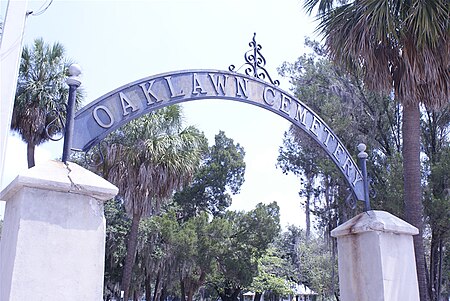Oaklawn Cemetery

Oaklawn Cemetery is the first public burial ground in Tampa, Florida, United States. The location was deeded in the mid-19th century and was described as the final resting place for "White and Slave, Rich and Poor". Oaklawn Cemetery is located at the intersection of Morgan Street and Harrison Street in downtown Tampa, about two blocks South of I-275. It has approximately 1,700 graves. Oaklawn Cemetery includes a section for Catholic burials called St. Louis Catholic Cemetery. The two graveyards were added as a Historic District to the U.S. National Register of Historic Places on September 19, 2017. The Sexton House was used for equipment storage and maintenance activities. The cemetery was of the "Rural Cemetery" style. The First Mayor of the City of Tampa, Judge Joseph B. Lancaster, is buried at Oaklawn, as is the 6th mayor, James McKay Sr. Others include pirates, slaves, yellow fever epidemic victims and confederate soldiers. Notable areas and gravesites in the cemetery include the gravesites of Henry Laurens Mitchell, John T. Lesley Family, Samuel Friebele, Charlie Wall, the Hooker Family, James McKay Jr., James C. Field, Joseph B. Lancaster, the Krause Family, the Wall Family, mass graves, gravesite of James T. Magbee, the gravesites of William and Nancy Ashley, gravesites of John P. Wall, James Gettis, grave art, and the "Cradle Graves".
Excerpt from the Wikipedia article Oaklawn Cemetery (License: CC BY-SA 3.0, Authors, Images).Oaklawn Cemetery
East Laurel Street, Tampa Tampa Heights
Geographical coordinates (GPS) Address Nearby Places Show on map
Geographical coordinates (GPS)
| Latitude | Longitude |
|---|---|
| N 27.954694444444 ° | E -82.457305555556 ° |
Address
Scott Street Parking Lot
East Laurel Street
33602 Tampa, Tampa Heights
Florida, United States
Open on Google Maps









